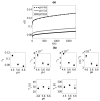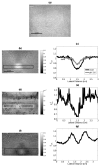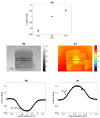pH-induced contrast in viscoelasticity imaging of biopolymers
- PMID: 19174599
- PMCID: PMC2702524
- DOI: 10.1088/0031-9155/54/5/001
pH-induced contrast in viscoelasticity imaging of biopolymers
Abstract
Understanding contrast mechanisms and identifying discriminating features is at the heart of diagnostic imaging development. This paper focuses on how pH influences the viscoelastic properties of biopolymers to better understand the effects of extracellular pH on breast tumour elasticity imaging. Extracellular pH is known to decrease as much as 1 pH unit in breast tumours, thus creating a dangerous environment that increases cellular mutation rates and therapeutic resistance. We used a gelatin hydrogel phantom to isolate the effects of pH on a polymer network with similarities to the extracellular matrix in breast stroma. Using compressive unconfined creep and stress relaxation measurements, we systematically measured the viscoelastic features sensitive to pH by way of time-domain models and complex modulus analysis. These results are used to determine the sensitivity of quasi-static ultrasonic elasticity imaging to pH. We found a strong elastic response of the polymer network to pH, such that the matrix stiffness decreases as pH was reduced; however, the viscous response of the medium to pH was negligible. While physiological features of breast stroma such as proteoglycans and vascular networks are not included in our hydrogel model, observations in this study provide insight into viscoelastic features specific to pH changes in the collagenous stromal network. These observations suggest that the large contrast common in breast tumours with desmoplasia may be reduced under acidic conditions, and that viscoelastic features are unlikely to improve discriminability.
Figures











References
-
- Bhattacharjee A, Bansal M. IUBMB Life. 2005;57:161–172. - PubMed
-
- Brown WH. Introduction to Organic Chemistry, Second Edition. John Wiley and Sons, Inc.; New Jersey: 2002.
-
- Chaturvedi P, Insana M, Hall T. IEEE Transactions on Ultrasonics, Ferrorelectrics, and Frequency Control. 1998;45:1022–1031. - PubMed
-
- Cumper CWN, Alexander AE. Australian Journal of Scientific Research Series A: Physical Sciences. 1952;5:153–159.
Publication types
MeSH terms
Substances
Grants and funding
LinkOut - more resources
Full Text Sources
Medical
